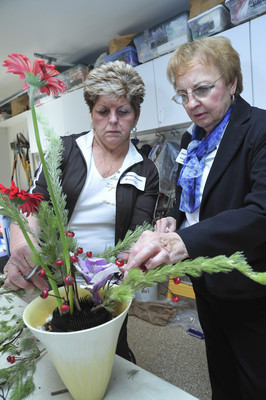No ordinary flower

A rose may always be a rose, but sometimes a beautiful flower arrangement is more than just a beautiful flower arrangement. For members of the Ikenobo Ikebana Society, the Japanese art of flower arranging is a form of meditation as well as a teaching tool about life and nature.
“It’s almost Zenlike; it feeds your soul,” said Sherran Taylor, a member of the Nevada chapter.
Jim Duval, who has been creating ikebana since 1990, agreed. “It’s a form of meditation and heightens your awareness of what goes on around you.”
“The philosophy (behind the placement of each element in an arrangement) is the same as Buddhism,” said Muriel Scrivner, the local sensei or teacher.
“In Japan, there are more men than women (who practice ikebana). Most of the policemen study ikebana to give them insight into the nature and lives of people,” she added.
Part of the reason behind the meditative quality of ikebana is the fact that it forces a person to concentrate only on what they are doing at that moment. “You’re so focused on doing your design that all else is gone. It’s a real stress reliever,” said Renee Vassallo, who started creating ikebana in 1987.
Scrivner has been doing ikebana for about 30 years. She began taking lessons in Japan, where she had moved with her husband, who was in the military. She said she enrolled in her first class her second week there and studied for eight years before they were restationed.
Society member Edwina Hammond also was introduced to ikebana while in Japan. Serving in the Navy at the time, she said she was overwhelmed to see fresh flowers on display in the middle of winter.
“I was from Oklahoma and it was the mid-1950s. We didn’t have things like that,” she said.
Hammond has been formally studying for about 20 years and continues to appreciate the fresh flowers used in arrangements that she displays throughout her home.
She recently hosted an open house at her home for which several members of the local chapter created arrangements. It also provided them an opportunity to hear about the annual Tanabata Autumn Exhibit by the Ikenobo Ikebana Society held in early November. Three local members attended the event in Kyoto, Japan, including Scrivner and Taylor.
The event attracted about 500 people from around the world, who attended lectures and workshops to hone their skills and view the arrangements, including some that were as large as the rooms they were in.
In addition to attending the exhibit, Scrivner and several of her students spent a week in Japan touring. She said a visit to one of the spas, where they bathed outdoors with snow falling around them, provided her with a great deal of inspiration for future arrangements.
Ikebana features three basic styles and 18 phases, each of which is learned through years of study and practice, Scrivner said. There are specific rules that must be followed when creating each arrangement, regardless of the style. A certificate is presented after each phase has been mastered by the student.
The basic styles are: rikka, which is the source for all other styles and uses contrasting but complementary materials to express the beauty of a natural landscape; shoka, a simpler style incorporating three branches; and free style, which is the newest and most expressive and colorful style.
According to a society brochure, plant cuts, which include branches as well as flowers, are arranged so that they are “filled with new beauty when placed in a new environment. Rather than simply re-create the shape a plant had in nature, we create with branches, leaves and flowers a new form which holds our impression of a plant’s beauty as well as the mark of our own spirit. Ikebana should also suggest the forces of nature with which plants live in harmony — branches bent by winter winds, a leaf half-eaten by insects.”
Scrivner said classes and workshops allow participants to work at their own pace and skill level. Because of this, anyone interested in learning ikebana can start taking lessons at any time.
In addition to teaching classes in Las Vegas and serving as chapter president, Scrivner teaches ikebana and is chapter president in Florida.
For more information about the local Ikenobo Ikebana Society, call Scrivner at 496-3763.